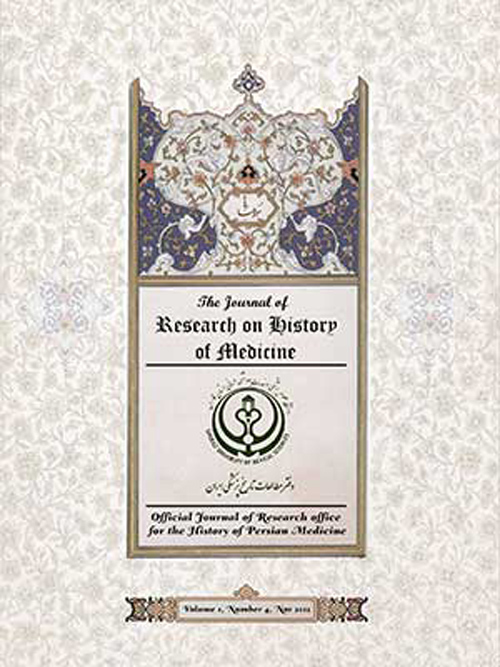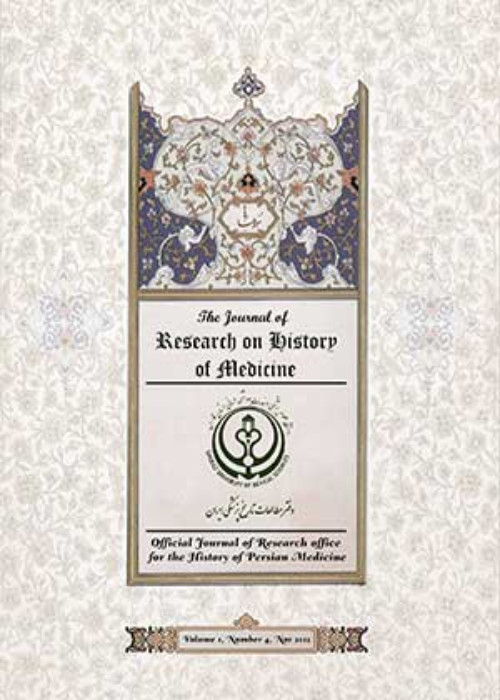فهرست مطالب

Journal of Research on History of Medicine
Volume:10 Issue: 4, Nov 2021
- تاریخ انتشار: 1400/09/14
- تعداد عناوین: 8
-
-
Pages 203-204
-
Pages 205-214Rabies is a fatal zoonotic disease that usually occurs via infected animal saliva. Two years after establishing the Pasteur Institute of Iran, the National Center for Reference & Research on Rabies, chaired by Dr. Mahdi Ghodsi, was formed to control and treat this disease in Iran. In 1955, Dr. Ghodsi, Dr. Balthazar, and Dr. Bahmanyar made a global transition in the rabies vaccination process. The rabies department was established in 1923. In 1976, it was selected to cooperate with the World Health Organization (WHO). Since 2013, according to ISO 15189, it was established as the rabies reference laboratory for the Ministry of Health and Medical Training and Veterinary Organization. For the 100th year of establishing the National Center for Reference & Research on Rabies, this article reviews the history of the center and its activities, such as diagnostic tests of suspected samples of rabies, assessment of the effectiveness of rabies vaccine, and evaluation of rabies vaccine potency.Keywords: Rabies, Research, diagnosis
-
Pages 215-242Epidemics are dramatic, far-reaching events. Their impact on society is unpredictable. Starting from the meaning of the Greek word epidemia, the paper highlights its topographical and social connotation (“stay at home, stay in a city”), from Homer to Hippocrates. By revisiting some of the most impactful epidemic events in ancient Greece and Rome, some of them well known, it focuses on their social and political consequences, the geographic spread and the medical features, the continuities in the reaction, and in the astonishment of societies. These events are the Athenian so-called plague of 431 BCE; the epidemic cough of Perinthos as narrated in the Hippocratic Collection; the Antonine plague in Rome around 166 CE; the epidemic taking place in China in the same years of the Antonine plague, suggesting a possible connection between the two, at a time when the first direct contacts between the two empires were established. The notion of contagion is considered. The paper also briefly recalls the so-called plague of Justinian, whose fateful aftermath has been often related to the collapse of the Roman Empire. Eventually, a reflection upon the different perceptions of an epidemic can provide us with some food for thought.Keywords: Epidemics, Ancient Greece, Ancient Rome, Ancient China, Hippocrates, Galen, Thucydides
-
Pages 243-252During the Elamite Middle Ages (around the mid-second millennium BC) in the city of Susa in Iran, the remnants of a naked young female figurine with a wide pelvic cavity which has kept its breasts with two hands have long left scholars to think about its identity and functions. The naked figurines which were scattered on the grounds in the alleys and streets were known as The Urban Figurines. The lab research proved that they were broken intentionally. Despite a lot of research done on their identity and functions, they have remained a mystery. This article, which is field research, by doing library studies, has attempted to study the function(s) of figurines assumed in archeology, religion, and medicine. The vertical line on the abdomen of the figurines without any abdomen protrusion can symbolize a mother in labor. This feature differentiates these figurines from other naked ones. Furthermore, the presence of this figurine along with Sin god, or the god of moon, which symbolizes giving a hand to women in difficult labor, which was also observed on the seals impression discovered in Susa Zone, leads us to the hypothesis that these Naked Elamite figurines could be a talisman to facilitate the delivery. The figurines were broken by exorcists during the rituals held to repel evil forces which caused the delay in labor. Some parts of the broken figurine were buried in the walls of the public places and some other parts were offered to the temples of the indigenous goddesses, such as Pinengir and Kiririsha.Keywords: Religion, Medicine, Archaeology, Faith Healing, Witchcraft, Complementary therapies
-
Pages 255-260The purpose of this study is to investigate Fars medical services monitoring, during fifteen years (1921– 1936). Available documents show that a separate office was established by the country health office to support medical affairs in the southern region of Iran, named the South Health Office in 1926. Illegal doctors were forced to stop working unless they obtain and present a degree from the Ministry of Education. At that time, there were 10 pharmacies at Shiraz, namely Adab, Nosrat, Behboodi, Razazade, Ziyaiyan, Iran, Khorshid, Shafa, Hafez, Fars Central. Pharmacies should have a valid license and work permit from the Ministry. There were a totally of 54 doctors, 11 pharmacists, and 3 midwives in Shiraz in 1932.Keywords: 19th century, Iran, Shiraz, Medical monitoring, Fars medical condition, educational status
-
Pages 261-270The journal of research on history of medicine (RHM) starts to be published from Feb. 2012. It passed its first decade of life by publishing current issue. By analyzing these 10 volumes, it shows that there are 284 articles that are written by 342 authors from 18 countries. These authors are affiliated to 90 institutions, that Shiraz University of medical sciences has the most contribution among them. In addition, the share of Iranian authors is more than other countries significantly. The journal is indexed in 14 indexing and abstracting databases. It needs to set a program for improving the quality of international cooperation, indexing of the journal and published papers for next decade.Keywords: medical journalism, History of medicine, Persian medicine, Publications


